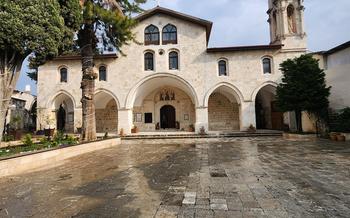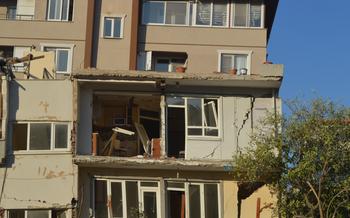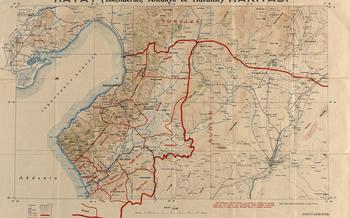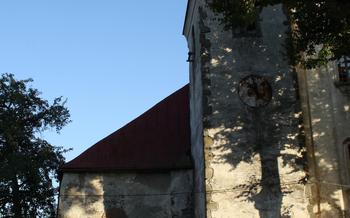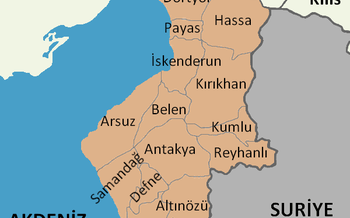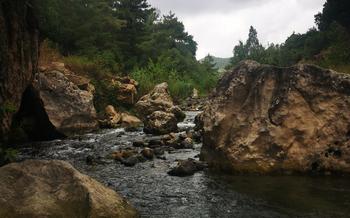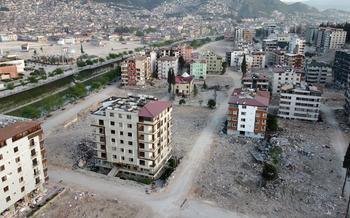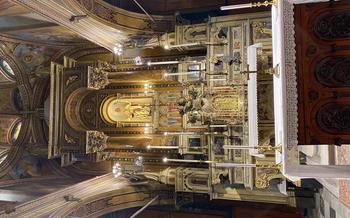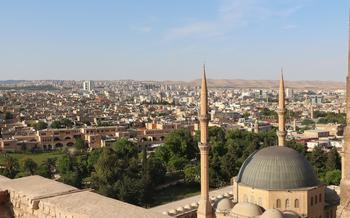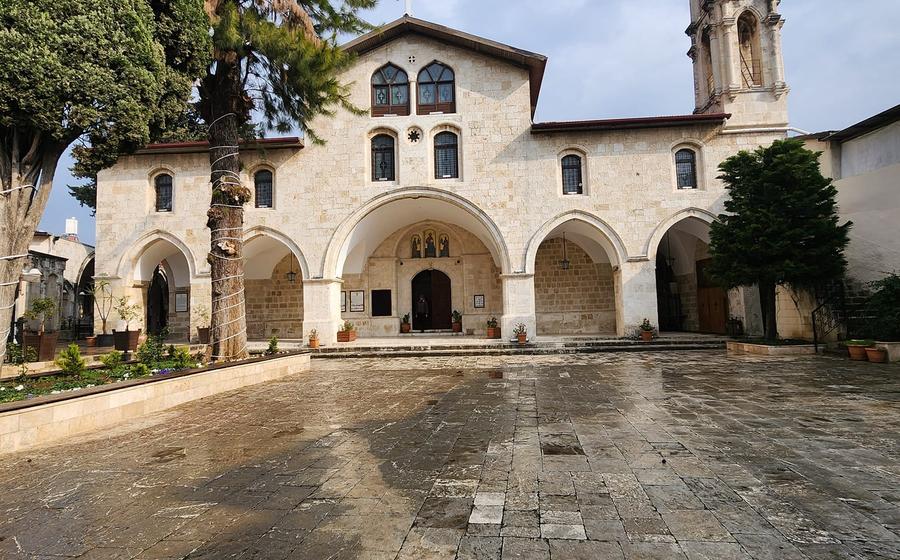
Antakya Orthodox Church
- Historical Significance
- Location and Accessibility
- Visiting Hours and Admission Fees
- Religious Importance
- Architectural Features
- Historical Events and Legends
- Cultural Significance
- Religious Art and Icons
- Photography and Videography
- Dress Code and Etiquette
- Nearby Attractions
- Local Cuisine and Restaurants
- Souvenirs and Shopping
- Accommodation Options
Historical Significance
The Antakya Orthodox Church, with its rich history spanning centuries, holds a significant place in the annals of Christianity and the city of Hatay. Founded in the 4th century, the church has witnessed numerous historical events and played a pivotal role in the development of Christianity in the region. It is believed to be built on the site where St. Peter, one of the twelve apostles of Jesus Christ, first established the Christian community in Antioch. The church's architectural style reflects a blend of Byzantine and Romanesque influences, adorned with intricate mosaics, frescoes, and carvings that narrate biblical stories and depict scenes from the life of Jesus. As a symbol of religious diversity and tolerance, the church has stood the test of time, showcasing the harmonious coexistence of different faiths in Hatay.
Location and Accessibility
The Antakya Orthodox Church is situated in the heart of the city of Antakya, Hatay, in southern Turkey. It is easily accessible by public transportation, with several bus lines stopping nearby. Visitors arriving by private vehicles can find ample parking spaces in the surrounding streets. A detailed map of the church's location and directions to reach it can be found on the church's official website or through online map services.
Visiting Hours and Admission Fees
The Antakya Orthodox Church is open to visitors from 9:00 AM to 6:00 PM daily, except during religious holidays or special events. It is advisable to check the church's website or contact the local Orthodox community for any variations in visiting hours. Admission to the church is free of charge. However, donations are welcome to support the upkeep and preservation of this historic landmark. Guided tours are available upon request, and audio guides are provided in multiple languages for a deeper understanding of the church's history and significance.
Religious Importance
The Antakya Orthodox Church is not just a historical landmark but also holds immense religious significance for the local Orthodox community. It is considered one of the most important churches in the region and serves as a spiritual center for Orthodox Christians. The church is dedicated to the Dormition of the Mother of God, a significant event in Orthodox Christianity. It is believed that the Virgin Mary spent her last days in a house near the church, and her tomb is said to be located within the church premises.
The Antakya Orthodox Church houses several relics and icons that are highly revered by the Orthodox faithful. These relics include fragments of the True Cross, the Holy Lance, and the Holy Sponge, all associated with the crucifixion of Jesus Christ. The church's icons, depicting biblical scenes and saints, are considered sacred objects and are often used for prayer and devotion.
Throughout the year, the church hosts various religious festivals and events that draw pilgrims and visitors from around the region. One of the most significant events is the annual celebration of the Dormition of the Mother of God, which takes place on August 15th. During this festival, the church is adorned with flowers and candles, and special services are held to commemorate the Virgin Mary's passing.
Architectural Features
The Antakya Orthodox Church boasts a unique architectural design that blends traditional Byzantine elements with local influences. Its exterior facade is adorned with intricate stone carvings and bas-reliefs, showcasing biblical scenes and figures. The church's most striking feature is its bell tower, which rises high above the surrounding buildings and offers panoramic views of the city. The interior of the church is equally impressive, featuring a spacious nave with a vaulted ceiling supported by massive columns. The walls are adorned with colorful frescoes depicting religious scenes, including the life of Christ, the Virgin Mary, and various saints. The church's most sacred space is the sanctuary, which houses the altar and the iconostasis, a wall of icons that separates the sanctuary from the nave. The iconostasis is adorned with intricate carvings and features a series of beautiful icons depicting various saints and religious figures.
Historical Events and Legends
The Antakya Orthodox Church has witnessed numerous historical events and is steeped in local folklore. One notable event is the visit of the apostle Peter, who is believed to have preached in the church during his missionary journeys. According to legend, Peter left his imprint on a stone in the church, which is now revered as a sacred relic.
Another significant event is the church's survival of several earthquakes that have struck the region. Despite the devastating earthquakes that have destroyed many buildings in Antakya, the church has remained remarkably intact. This is attributed to the strong construction and the belief that the church is protected by divine intervention.
Local folklore also surrounds the church. One story tells of a young woman who was saved from a deadly illness after praying to an icon of the Virgin Mary in the church. Since then, the icon has become a popular pilgrimage site for those seeking healing and miracles.
The Antakya Orthodox Church is also associated with several famous personalities. One of the most notable is St. Ignatius of Antioch, who was the third bishop of the church. St. Ignatius is remembered for his letters, which are considered important theological works in the early church.
These historical events and legends add to the mystique and charm of the Antakya Orthodox Church, making it a place of pilgrimage and spiritual significance for believers from around the world.
Cultural Significance
The Antakya Orthodox Church is not just a place of worship, but also a cultural landmark of immense significance. As a symbol of religious diversity and tolerance, the church has played a crucial role in shaping the cultural fabric of the region. It is a testament to the rich history and diverse ethnicities that have coexisted in Hatay for centuries. The church's architecture, art, and traditions reflect the unique blend of Eastern Orthodox and local influences, creating a harmonious fusion of cultures.
Throughout history, the church has been a focal point for religious celebrations, festivals, and cultural gatherings. The annual feast of St. Peter and St. Paul, held every June, attracts thousands of pilgrims and visitors from around the region. During these festivals, the church transforms into a vibrant hub of cultural activities, showcasing traditional music, dance, and local cuisine. The church also hosts regular events, workshops, and exhibitions aimed at promoting cultural understanding and preserving the region's rich heritage.
Religious Art and Icons
The Antakya Orthodox Church is a treasure trove of beautiful religious art and icons that captivate visitors with their intricate details and profound symbolism. These artworks serve as visual representations of the church's rich history, beliefs, and spiritual traditions.
The icons, which adorn the walls and iconostasis of the church, depict various saints, biblical figures, and scenes from the life of Jesus Christ. Each icon is meticulously crafted using traditional techniques and materials, such as egg tempera on wood, and exudes a sense of reverence and spirituality.
One of the most significant icons in the church is the "Panagia of Antioch," which is believed to date back to the 6th century. This iconic representation of the Virgin Mary holds a special place in the hearts of the local Orthodox community and is revered for its miraculous powers.
Visitors can also admire the stunning frescoes that adorn the church's interior. These vibrant and colorful paintings depict scenes from the Bible and the lives of the saints, adding to the church's already rich visual tapestry.
Whether you're an art enthusiast, a history buff, or simply someone seeking spiritual inspiration, the religious art and icons of the Antakya Orthodox Church are sure to leave a lasting impression and deepen your understanding of this sacred space.
Photography and Videography
When visiting the Antakya Orthodox Church, it is essential to be mindful of the sacred nature of the site and to respect the religious customs and traditions. Photography and videography are generally permitted inside the church, but there are a few guidelines that visitors should follow.
Before taking any photos or videos, it is advisable to seek permission from the church authorities or the designated personnel. This is to ensure that visitors are not disrupting any ongoing religious ceremonies or activities. It is also crucial to be respectful of the privacy of other visitors and to avoid capturing images of people without their consent.
When taking photos or videos, visitors should be discreet and avoid using flash photography, as this can be disruptive and disrespectful. It is recommended to use natural light or low-light settings to capture the beauty of the church's interior without disturbing the ambiance.
Visitors should focus on capturing the architectural features, frescoes, and religious icons that make the Antakya Orthodox Church unique. It is also advisable to take photos from various angles to capture the grandeur and scale of the church.
After taking photos or videos, visitors should be mindful of their surroundings and ensure that they do not leave any equipment or accessories behind. It is essential to respect the sanctity of the church and to leave it as they found it.
Dress Code and Etiquette
When visiting the Antakya Orthodox Church, it is important to dress respectfully and observe the local customs and traditions. Modest attire is expected, and visitors should avoid wearing shorts, tank tops, or revealing clothing. For women, it is customary to cover their heads with a scarf or shawl while inside the church. Visitors should also be mindful of their behavior and conduct, maintaining a respectful and quiet demeanor while inside the church. Photography and videography are usually allowed, but it is essential to ask permission from the church authorities or any attending clergy before taking any photos or videos. Flash photography or the use of tripods may be restricted to preserve the sanctity of the church's interior. Visitors should also avoid disturbing ongoing religious services or ceremonies and be respectful of the worshippers and clergy present.
Nearby Attractions
In the vicinity of the Antakya Orthodox Church, travelers can uncover a treasure trove of captivating attractions. Just a short distance away lies the Hatay Archaeology Museum, a must-visit for history buffs, where ancient artifacts and relics narrate the region's rich past. Embark on a culinary adventure at the nearby traditional Turkish restaurants, savoring delectable dishes that tantalize the taste buds. For those seeking a serene retreat, the picturesque Habib-i Neccar Mosque, with its serene ambiance, invites visitors to immerse themselves in tranquility. Explore the vibrant Hatay Bazaar, a shopper's paradise brimming with local handicrafts, souvenirs, and delectable treats. Plan a day trip to the breathtaking St. Simeon Monastery, perched atop a hill, offering panoramic views that will leave you spellbound. With so much to discover, history, culture, and natural beauty converge, creating an unforgettable tapestry of experiences.
Local Cuisine and Restaurants
After exploring the spiritual and cultural significance of the Antakya Orthodox Church, indulge in the delectable flavors of Hatay's cuisine. Just a stone's throw from the church, you'll find an array of restaurants and eateries offering mouthwatering Turkish dishes.
For an authentic taste of the region, try the famous "künefe," a crispy pastry filled with melted cheese and topped with sweet syrup. Another must-try is "hummus," a creamy dip made from chickpeas, tahini, and lemon juice. Enjoy it with freshly baked bread or vegetables.
If you're looking for a hearty meal, savor the flavors of "lahmacun," a thin, crispy flatbread topped with minced meat, vegetables, and spices. For a vegetarian option, try "piyaz," a refreshing salad made with white beans, tomatoes, onions, and parsley.
To satisfy your sweet tooth, treat yourself to "baklava," a rich pastry filled with nuts and sweetened with honey or syrup. And don't miss out on the delicious Turkish coffee, a strong and aromatic brew that's a perfect way to end your culinary journey.
For an unforgettable dining experience, head to one of the many traditional restaurants in the area. Enjoy the warm hospitality and savor the authentic flavors of Hatay's cuisine.
Souvenirs and Shopping
After exploring the spiritual and architectural wonders of the Antakya Orthodox Church, take some time to browse the nearby shops and markets for unique souvenirs and local handicrafts. The area around the church is home to several charming boutiques and stalls where you can find a variety of mementos to cherish your visit.
Look out for traditional Turkish handicrafts such as hand-woven carpets, intricately designed pottery, and beautiful jewelry adorned with semi-precious stones. These items make for excellent gifts or keepsakes to remind you of your time in Hatay.
Don't miss the opportunity to visit the local bazaar, where you can immerse yourself in the vibrant atmosphere and haggle for the best prices. Here, you'll find an array of souvenirs, from colorful textiles and spices to antique trinkets and handmade souvenirs.
As you shop, remember to embrace the local customs and traditions. Be respectful when bargaining, and don't be afraid to ask for assistance if you need help finding something specific. Whether you're looking for a unique piece of art or a simple reminder of your travels, the shops and markets near the Antakya Orthodox Church offer something for everyone.
Accommodation Options
When visiting the Antakya Orthodox Church, there are several accommodation options available for visitors to choose from. For those seeking a comfortable and luxurious stay, the Divan Hotel Antakya offers elegant rooms with modern amenities and stunning views of the city. Located just a short walk from the church, the Antakya Hilton is another excellent option, providing spacious rooms and a range of facilities, including a spa, fitness center, and rooftop pool.
For budget-conscious travelers, the Antakya Hostel offers affordable dormitory-style accommodations and a friendly atmosphere. Alternatively, the Antik Otel provides simple yet comfortable rooms at reasonable rates. Both options are located within easy walking distance of the church.
To secure the best deals and availability, it's advisable to book your accommodation in advance, especially during peak tourist season. Online booking platforms and travel agents can assist in finding the most suitable options based on your preferences and budget.
